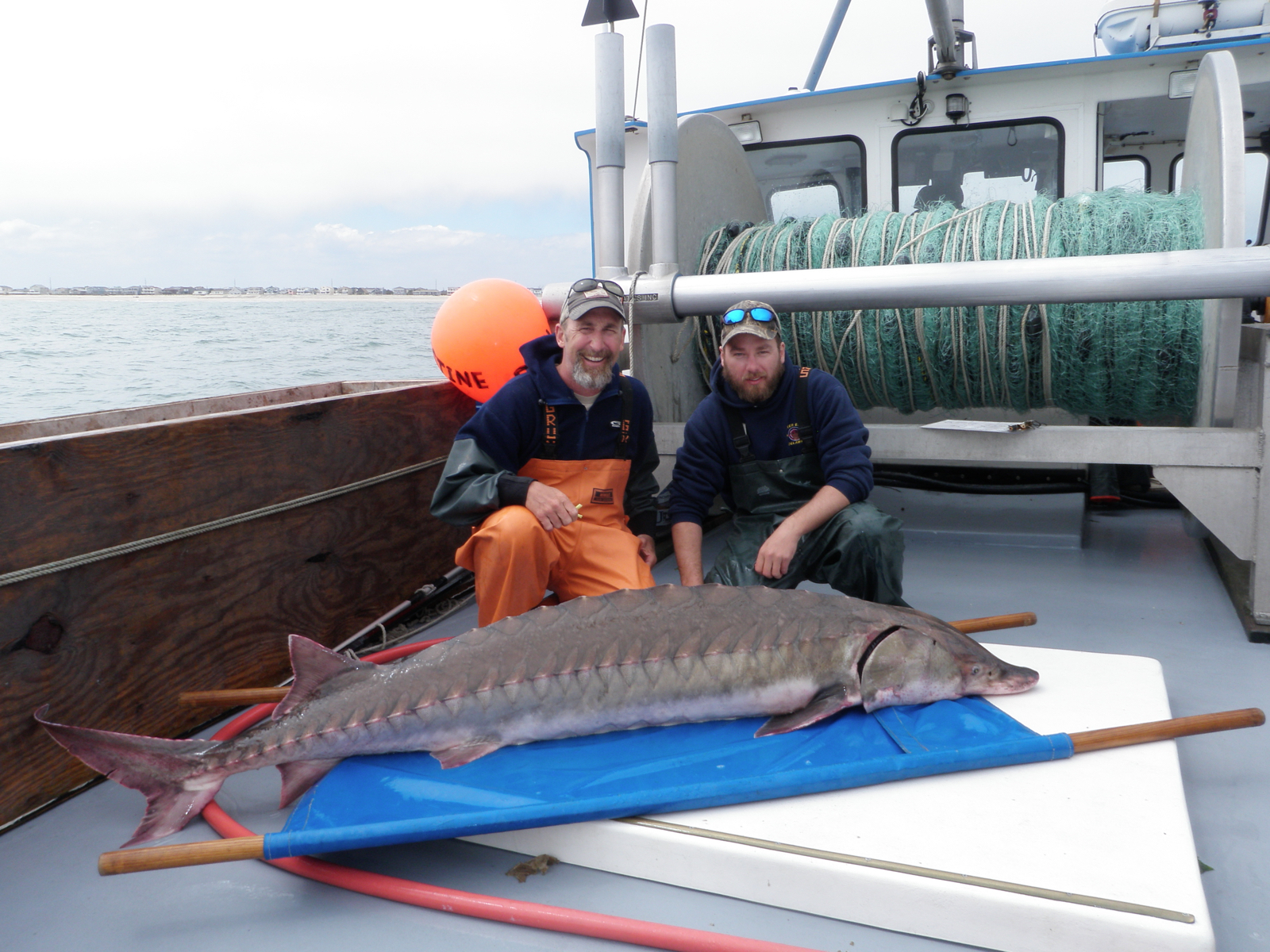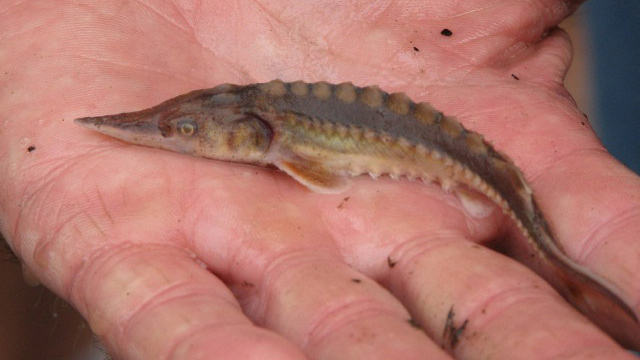A sturgeon’s offspring has that sort of face only a mother sturgeon could love: rubbery prehensile lips over a toothless grin, with four sensory barbels dangling from the underside of its shovel-shaped snout. For many of us, this fish’s primordial appearance might be unsettling. But a feeling akin to maternal affection might be the best way to describe the reaction of researchers who, in 2009, while sampling just downstream of Philadelphia, captured the first juvenile Atlantic sturgeon that had been found in the Delaware River in decades.
“Everyone on the team was pretty excited when we finally found one,” says Matt Breece, who at that time was a graduate student at Delaware State University, and part of a team of researchers working with NOAA Fisheries to determine where Atlantic sturgeon occur, and whether they are reproducing.
A Remarkable Journey
It’s during this very time of year, between April and May, that mature sturgeon embark on a remarkable journey from their ocean water home to the freshwater spawning and nursery grounds of their ancestors – near places along the river that that today we call Wilmington, Philadelphia and Trenton.
“Every year you see the flowers bloom and things start to come alive in the spring. Well, it used to happen in the river too – with runs of hundreds of thousands of sturgeon, shad and river herring,” says Breece, “but today, these populations are measured in handfuls.”
Now, thanks to a new study led by The Nature Conservancy, scientists and resource managers know even more about sturgeon reproducing in the river. We’ve learned about what conditions may be limiting recovery of this ancient fish, and what can be done to help.

In the early 19th century Atlantic sturgeon were so plentiful in the Delaware River that during their annual spawning run (it’s said) the fish would upset small boats. Not hard to imagine from a fish that can reach 14 feet in length and weigh up to 800 pounds. With their size, bizarre looks, and bodies covered by bony plates instead of scales, the fish have an ancient and primitive appearance. And they should, because Atlantic sturgeon were around when dinosaurs roamed the earth and have changed very little in more than 70 million years.
The Caviar Capital of North America
The demand for caviar led to the establishment of the first commercial sturgeon fishery on the Delaware around 1870, when an estimated 180,000 adult females could be expected to make the spring spawn. What likely started as an enterprise to provide caviar to Philadelphia’s finest restaurants and the luxury estates along the Main Line developed into a major international export, and the Philadelphia region became known as the ‘caviar capital of North America.’
For three or four decades, 75 percent of the sturgeon caught in the U.S. came from the Delaware River. The catch peaked in 1890 and within a decade, a spawning run that has marked spring in the Delaware since the last Ice Age took a population nose dive to less than 1 percent of its historic numbers.
The population could not recover from the combination of fishing pressure and poor water quality. Fishing continued, but with limited success, until a moratorium shut it all down in the 1990s.
The Most Urbanized Stretch of the River
A decade after a ban on sturgeon fishing all along the Atlantic coast, the fish population had failed to recover and in 2012, the Delaware River sturgeon were among several populations listed as endangered by NOAA Fisheries. In the listing, NOAA cited major threats to the existence of the species including ship strikes, channel dredging and poor water quality.
A listing under the Endangered Species Act requires that federal agencies develop a recovery plan, and that requirement led, indirectly, to the Conservancy’s study of specific habitat needs: dissolved oxygen, flow, and the encroachment of salt water on the sturgeon’s spawning ground, which happens to be located in the most urbanized stretch of the river, between Trenton, New Jersey and Wilmington, Delaware.
“This study is a little different, because when we look at fish habitat, we’re often looking at discrete physical places” explains Tara Moberg, a freshwater scientist for the Conservancy. “Here, by coupling data on fish movement with water quality data, we learned that spawning and nursery habitat on the Delaware drastically moves up and downstream, from season to season, and year to year, depending on the water quality conditions.”
For example, during the worst drought on record, the “salt front’’ (where the fresh water of a river meets the saline ocean water) moved upstream, affecting the suitability of 40 miles of the fish’s normal freshwater spawning habitat.
More recently, during a dry spell in 2010, the salt front moved upstream affecting between 10 and 20 miles of suitable spawning habitat. At the same time, there was a drop in dissolved oxygen that would have been lethal to sensitive eggs.

The research discovered that during the poor water quality year in 2010, no young of the year sturgeon were found, explains Moberg, the lead author of the report. “Conversely, during 2009, 2011 and 2014, dissolved oxygen, flow and salinity conditions were better and young sturgeon were found.”
Hope for Sturgeon
The Conservancy convened a team of experts in sturgeon and water quality to analyze data like this, in addition to studies on sturgeon behavior in other rivers, to make recommendations for dissolved oxygen, salinity, and flow conditions that would support spawning and early life stages into the future. The research team also documented the extent of spawning and nursery habitat in the freshwater portion of the river.
The good news is that, “in some areas all we need is a 1 milligram-per-liter bump in the dissolved oxygen to get into a zone where the young fish can survive,” said Moberg.
Mari-Beth DeLucia, a conservation manager for the Conservancy and one of the study’s authors, noted that some recommendations may be achieved with best available technologies.
“In some cases, we may already be halfway to achieving these goals, but the next half may be expensive, so it’s important that these recommendations are clear, science-based and practical,” Delucia says. “And this is at the core of why this report is so valuable – all parties working to manage fish, flows and water quality in the Delaware River should be able to use the findings.”
As is often the case, climate change adds a layer of uncertainty, as sea level rise is shifting the average salt front upstream. DeLucia has hope that the Atlantic sturgeon could survive climate shifts, if given the chance.
“These fish are very resilient or they wouldn’t be here anymore,” she says. “If we can increase their population, they should be okay. They can adapt and they will, but like us, they first need a little space to safely move, grow and develop.”




I am an artist researching sturgeon photos for a block print I’m designing. I live near Sturgeon Creek in Maine (near Great Bay) yet there are no more sturgeon. I was curious as to whether there are efforts to restore this magnificent fish… and here is my answer! This article is a couple of years old… how are you progressing?
Found a dead Sturgeon where Highland ave. deadends at the Del. river in Chester Pa. reported it to Pa Fish Comm. I can send a picture to any of the above mentioned people.
Hi Rick — thanks for being so observant. I’m sorry to hear about the dead sturgeon. I’ll get you the right contact information and email you privately with the best person to send images to.
Thanks!
Cara
Hell of a Fish! I love fishing out of my Kayak. I use my favoriteKayaking app all the time.
I think I see a trawl in the delaware around tinicum shoals. Are they catching any?